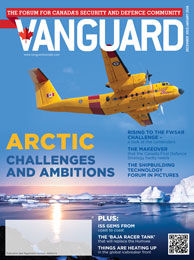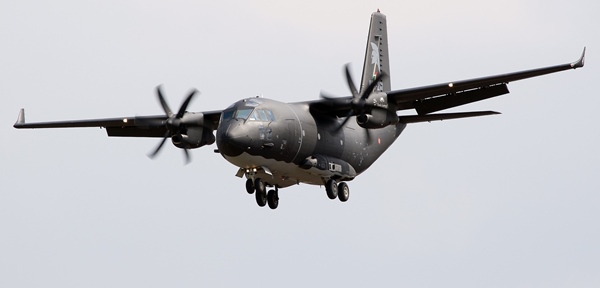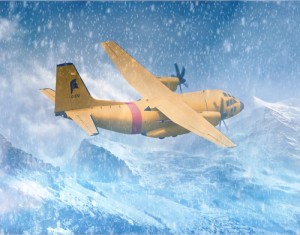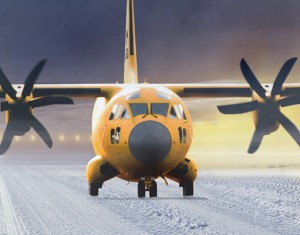The twin Rolls Royce engines of the Peruvian Air Force’s C-27J transport and search and rescue aircraft roared in urgency. In an instant, the airplane was speeding down the tarmac and in mere seconds its front wheels lifted off the ground and the aircraft leaped into the air even before it was halfway down the runway.
The C-27J took a sharp turn to the right and headed straight into the dark clouds hovering just past the blue skies. No, the multi-mission airlifter was not flying towards some trouble spot. It was merely carrying its Peruvian crew on the first leg of their journey home after concluding a media briefing with Canadian reporters at the Gatineau-Ottawa Executive Airport.

The C-27J is Finmeccanica-Alenia Aermacchi’s entry to the Royal Canadian Air Force’s (RCAF) request for proposal for a fixed-wing search and rescue (FWSAR) aircraft to replace its current fixed-wing SAR fleet.
Bids were initially supposed to be in by September 28, 2015, but the process has been extended and now competing companies have until January 11, to submit their entries. The FWSAR program was originally meant to replace the remaining fleet of six DeHavilland CC-115 Buffalos while relieving the Canadian Forces Hercules fleet of its SAR duties. Planning for the FWSAR replacements began back in 2002 and funding for 15 new aircraft amounting to $1.3 billion was allocated in March 2004. However, the program has been plagued with woes and delays. That budget is now $1.55 billion.
Apart from the Italian-made C-27J, two other aircrafts are widely considered as frontrunners: the C295 from Airbus Military and Lockheed Martin’s C-130J.
Boeing-Bell has said their V-22 Osprey would not be offered as a FWSAR candidate. Bombardier has also indicated that it is no longer offering its Q series Dash 8 planes for the project because of the rear ramp requirement on the FWSAR aircraft.
Steve Lucas, senior advisor to Alenia Aermacchi, is confident that Team Spartan, the alliance of Canadian aerospace companies that are working with Alenia to provide requisite “Canadian content” and services, will deliver the goods the RCAF is looking for.
The C-27J offers the best solution FWSAR solution for Canada,” Lucas told Vanguard Magazine. “It flies faster, higher, carries more payload at longer distances and can operate from smaller airfields than its direct competitors.”
Beyond the operational performance of the C-27J, Team Spartan also offers an industrial benefits package that includes hundreds of long-term, high-value jobs and extensive investments in Canadian firms and technology, he said.
“Our value proposition mix and Canadian participation are the highest quality,” according to Lucas.
Mission requirements
Canada has one of the most challenging search and rescue environment in the world. The country comprises the second largest landmass in the world encompassing approximately 18 square kilometers surrounded by the longest coastline. The Canadian SAR area extends from the Rocky Mountains, to out territorial waters and the Arctic. The expanse is subject to temperatures from 40 C to -50 C.
The FWSAR aircraft must be able to reach the most remote Canadian location in the shortest time. The FWSAR fleet must have 95% availability for at least one aircraft in each SR region and a second aircraft must be available 70% of the time.
The country’s three Joint Rescue Coordination Centres in Halifax, Nova Scotia, Trenton, Ontario, and Victoria, British Columbia handle an average of 8000 air and marine SAR cases each year. Canadian Force aircraft alone conduct more than 1,000 missions a year.
Fixed-wing SAR missions include responding to downed aircraft emergencies and distressed vessels, emergency medical evacuation from remote communities, as well as assisting provincial and territorial authorities.
The FWSAR aircraft will need observation windows on either side of the fuselage with corresponding observer seats and an intensive care medevac package. The RFP requires a surveillance radar with a mandatory 220-degree FOV (360 degree-rated), and an Electro-Optical/Infrared turret fully managed by an avionics-integrated mission system with the ability to downlink imagery.
Also required is a satellite voice and data communications capability and sensor operator/mission manager workstation or workstations along with a flight management system with performance in line with the latest International Civil Aviation Organization (ICAO) performance-based navigation standards.
The accomplish its primary mission as a SAR aircraft and its secondary mission as a tactical transport the FWSAR airplane would require ramp access to the cargo area.
Roll-on/roll-off multi-mission capabilities
“It is a powerful and robust plane,” says the Peruvian Air Force’s Col. Alejandro Marusic Caceda, of the C-27 J. “It can take off from a short runway and can climb rapidly to the maximum cruise ceiling of 30,000 feet and while carrying heavy payload.”
He also likes the large and tall cabin of the aircraft. The C-27J has a maximum cabin height of 2.60 metres which makes it easier for the crew to work while standing upright.
Col. Caceda says the C-27J is perfect for operation in the mountainous regions of Peru. The South American company signed for two of light tactical aircraft in 2013 and bought another two in 2014. Peru is looking to replace fleet of 12 aging Soviet-era Antonov AN 32s.
As of September 2014, 76 units of the aircraft have been ordered by 12 forces around the world including The U.S. Special Operations Command (7), the U.S. Coast Guard (14), the Royal Australian Air Force (10), the Italian Air Force (12) and the Greek Air Force (8), among others.
The U.S. version of the aircraft is a comprehensive “C3-ISR/ISTAR” and fire support platform capable of quick reconfiguration to enable performance of multiple missions while maintaining primary airlift capability.
Lucas says the Canadian version of the C-27J will share “a lot of commonalities” with the U.S. Coast Guard and Royal Australian Air Force aircrafts although Team Spartan is updating the baseline configuration to include additional capabilities and functionalities. The enhancements will contain upgrades to avionics and performance such as a new management systems, extra power for the engines and an increased maximum takeoff weight.
The FWSAR-specific modifications include:
- Mission systems pallet from General Dynamics Mission Systems Canada with two operator and two crew seats from Martin Baker
- SeaSpray 7500 search radar supplied by Selex ES and Radome from IMP Aerospace
- MX-15 EO/IR turret supplied by L-3 Wescam
- Additional observation windows on the paratrooper doors from Airdyne
- Two flare launchers on the fuselage supplied by Airdyne
- Internal layout designed by IMP Aerospace
- Iridium satellite from FLYHT Aerospace
- ATC radios from Rockwell Collins
Canadian content
General Dynamics Mission Systems Canada will act as Team Spartan’s mission systems integrator. It will modify the aircraft to accept high-tech sensors and the computers that manage them. The company will also serve as the in-service support integrator for the program.
The training development team of military communications and electro-optics firm DRS Technologies Canada Ltd., will design, oversee and manage the creation and maintenance of all courseware and training aids for the duration of the contract.
Kelowna, B.C. aviation services company KF Aerospace, which specializes in heavy aircraft maintenance and modifications will provide Team Spartan with maintenance, supply chain and repair engineering ISS as well as pilot and maintenance training management support for the C-27J.
“The C-27J will be modified, missionized and supported in Atlantic Canada,” says Lucas.
Find other engaging content 
in the Dec-Jan 2016 issue of Vanguard Digital. Click here.



